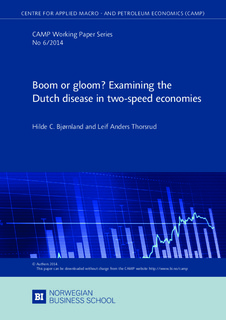Boom or Gloom? Examining the Dutch Disease in Two-Speed Economies
Working paper
Permanent lenke
http://hdl.handle.net/11250/223215Utgivelsesdato
2014Metadata
Vis full innførselSamlinger
Sammendrag
Traditional studies of the Dutch disease do not account for productivity spillovers
between the booming resource sector and other domestic sectors. We put forward a
simple theory model that allows for such spillovers. We then identify and quantify
these spillovers using a Bayesian Dynamic Factor Model (BDFM). The model allows
for resource movements and spending effects through a large panel of variables at
the sectoral level, while also identifying disturbances to the commodity price, global
demand and non-resource activity. Using Australia and Norway as representative
cases studies, we find that a booming resource sector has substantial productivity
spillovers on non-resource sectors, effects that have not been captured in previous
analysis. That withstanding, there is also evidence of two-speed economies, with
non-traded industries growing at a faster pace than traded. Furthermore, com-
modity prices also stimulate the economy, but primarily if an increase is caused
by higher global demand. Commodity price growth unrelated to global activity is
less favourable, and for Australia, there is evidence of a Dutch disease effect with
crowding out of the tradable sectors. As such, our results show the importance
of distinguishing between windfall gains due to volume and price changes when
analysing the Dutch disease hypothesis.
